This post contains affiliate links.
Fudge is one of those irresistible yet simple desserts that leaves a melt-in-your-mouth chocolatey experience you cannot forget! This treat is super rich and smooth but sometimes we end up with a grainy fudge that is not fun to eat.
As a general rule, the best way to fix and prevent grainy fudge is to add fat. Adding fat, such as cream or butter, to the fudge mixture helps prevent sugars from crystallizing which produces a grainy texture. The fat also helps smooth out the overall texture of the fudge.
I’ve experimented with many batches and I finally found the perfect tricks to help find the rich texture we all love with fudge. Below, I have explained ways to fix and prevent grainy fudge every time!
Why Is Your Fudge Grainy?
Generally speaking, fudge will become grainy if the sugar in the batter has crystalized too soon. This can occur if the batter rapidly cooled down after the heating process. Another factor that contributes to a grainy fudge is if the batter wasn’t heated properly to melt the large sugar crystals.
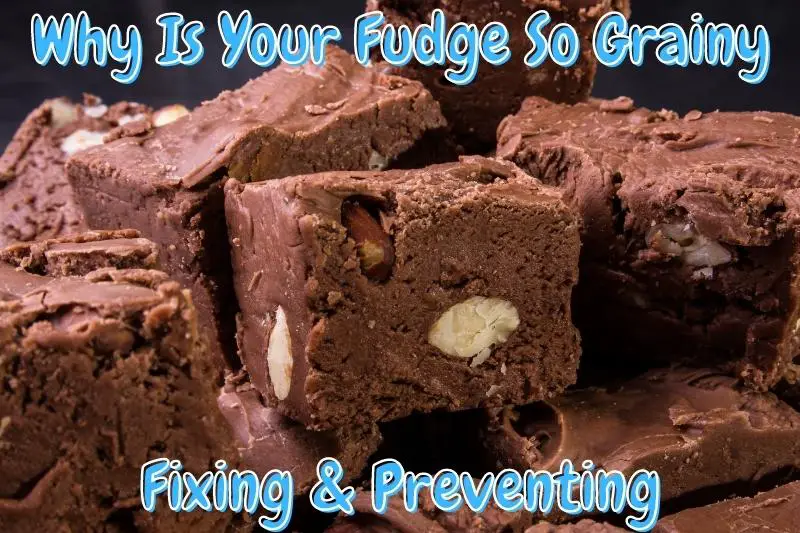
If your fudge turned out grainy there are usually a few reasons why.
Sugar tends to crystalize if the mixture has been beaten too long.
This means that you may have accidentally set your batch up for failure before it even made it into the pot. If you didn’t overmix it then there are a couple of other reasons why it may have turned grainy.
While it’s always important to keep a watchful eye over your dishes when preparing them, it’s especially important to keep your eye on fudge as it cooks.
Below, I found a video that helps to understand more about the science behind fudge:
*By the way, if you’re looking for a good mold to make your fudge in, I’ve recently come across the perfect Silicone Fudge Mold made from small rectangles. This Silicone Mold was perfect for my fudge bites dessert! You can check out this Fudge Mold on Amazon!
While the process of mixing the fudge is fairly simple, there’s very little room for error once it starts to cook.
You need to make sure that the temperature is warm enough so that it boils but not so hot that it scalds the bottom portion and burns it.
You want your fudge to reach the right temperature, but anything lower or higher will likely result in grainy fudge.
Make sure you’re checking the temperature often!
Just as important as it is to allow your fudge to reach a high enough temperature, you also need to give it enough time to cool down in order to set it properly.
While you and your guests may be impatiently waiting to try your delicious fudge, it’s important to allow it to cool for at least an hour (or until it reaches 110 degrees Fahrenheit) before you start to section it into smaller bites.
How Do You Fix Grainy Fudge?
Grainy fudge can be fixed by heating it back up on the stovetop to the appropriate temperature. Once it has boiled for the specified amount of time allow it to gradually cool. The texture should be smoother than before. When this doesn’t work, add a bit of butter to the mixture to smooth it further.
The good thing about fudge is that you can easily fix it if it’s too grainy or the texture is slightly off. Add about a cup of water to your mixture and place it back in the pot.
The water will restore any moisture that evaporated during the cooking process and will allow you to try again.
Bring your mixture with the added water back up to a boil. Allow it to cook for about seven minutes or until it reaches about 236 degrees Fahrenheit.
Make sure you leave it alone and don’t stir it while it boils again! After it’s thoroughly heated, remove it from the heat and allow it to cool again. The texture should improve tremendously.
*By the way, I recently wrote an article about Why Did Your Fudge Get So Hard? This article talks about all the reasons why your fudge gets hard as well as how to fix and prevent it so that it never happens again. You can check out this article here!
Another great tip I found when it comes to fixing grainy fudge is by adding fat! Some fats include:
- Butter
- Cream
- Clotted Cream
- Double Cream
These are all great fats that can help restore the texture of your fudge. Simply reheat the fudge in a saucepan and add 1-2 tablespoons of butter to your mixture.
Continue heating until fully melted and then gradually cool down.
Either method works well but the only notable difference is that adding fat will also add a slight sheen to your fudge which I prefer.
How To Prevent Grainy Fudge From Happening?
To avoid a grainy fudge, it is best to allow the mixture to reach the appropriate temperature when it is on the stovetop. If it is not hot enough, the sugar crystals will not dissolve. Use a candy thermometer to verify it is hot enough. Also, allow the fudge to cool gradually to avoid clumps.
To do this, I prefer using a thermometer. I recently came across a Candy Thermometer with a Hanging Hook that works perfectly for this! I use this thermometer for pretty much anything I make in the kitchen that requires knowing the temperature. You can check out this thermometer on Amazon!
While fixing your grainy fudge can be fairly simple, it’s better to avoid and keep it from happening in the first place.
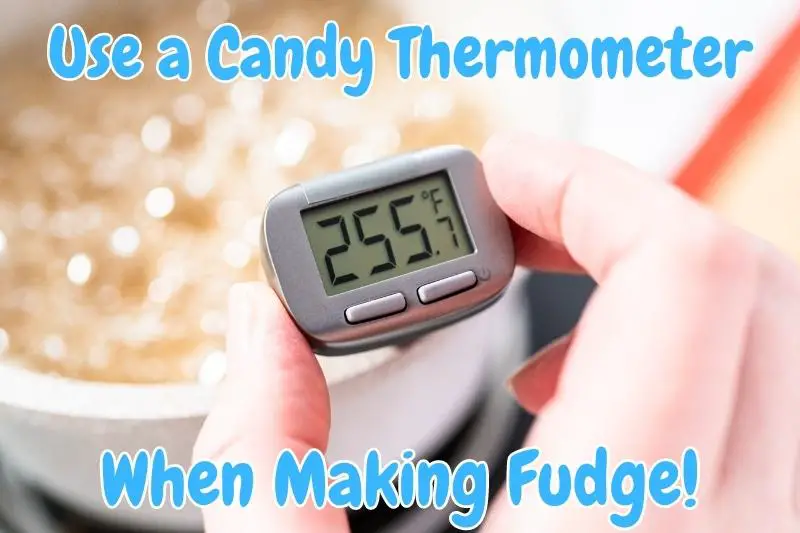
You can easily prevent grainy fudge before it happens by following a few simple, yet important tips.
First, avoid stirring your fudge while it’s boiling. You want the crystallization process to happen later as it’s cooled down, not while it’s boiling.
Also, be sure your fudge reaches the right temperature before allowing it to cool back down.
By keeping an eye on the temperature, setting your timer, and not stirring it while it’s boiling you’ll improve your chances of having a successful batch of fudge.
What Should Be The Ideal Fudge Texture
Generally speaking, the ideal fudge texture is smooth, firm, and creamy with each bite. A great fudge will hold its shape when it is cut due to its firmness but melts in your mouth because of its creaminess. Fudge should never be grainy or gritty in texture.
There are few desserts as decadent and delicious as a classic piece of chocolate fudge. It’s the texture that makes fudge such a joy to create and share with family and friends.
The ideal texture of fudge will be smooth and creamy, yet firm when you bite into it.
You don’t want the texture of your fudge to be too soft as it will most likely melt before you can enjoy it. You also don’t want your fudge to be hard and crunchy, or you may hurt your teeth when you bite into it!
Here are some characteristics of the perfect fudge:
| Characteristic | Description |
|---|---|
| Creaminess | Smooth & creamy texture; should feel like velvet on your tongue; No graininess. |
| Appearance | Free from air bubbles, cracks, or grainy spots; surface should be smooth |
| Firmness | Free from air bubbles, cracks, or grainy spots; the surface should be smooth; dense & chewy |
| Sweetness | Should be well-balanced; not overly sweet; can be balanced with nuts or chocolate chunks |
| Consistency | Should have a consistent texture throughout with no random pockets of hardness or softness |
| Cutting Ability | Ability to cut fudge without it breaking apart easily or crumbling |
By paying careful attention to detail and not rushing the process you’re sure to end up with a delicious batch of fudge!
*By the way, I recently wrote an article about Why Your Fudge Became So Soft. This article breaks down all the reasons why your fudge is soft as well as how to fix and prevent it from happening again. You can check out this article here!
How Long Should Fudge Boil For?
As a general rule, fudge should boil for around seven to nine minutes to fully dissolve the sugar crystals. This, of course, depends on the recipe that is being used. This may also depend on the temperature that is used as well as the preferred fudge texture.
Timing is everything when it comes to preparing the perfect batch of fudge. You don’t want it to overcook, however, you don’t want to undercook it either.
Once your fudge mixture has been brought up to boil set your timer for seven minutes and keep an eye on it.
Once the time is up, check your fudge mixture to see if it’s ready to cool. You need to get your fudge to reach about 236 degrees before cooling it down.
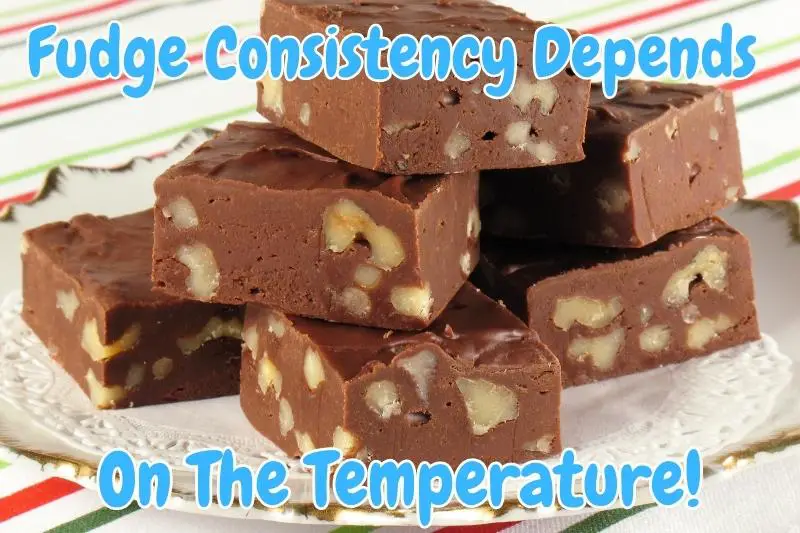
Another good way to check and see if it’s ready is by using the “softball test”.
Get a glass of cold water and carefully scoop a bit of fudge from your pan. If it forms a lump that resembles a softball once it’s submerged in the water then your fudge is ready to begin the cool-down process.
According to Ricardo Cuisine:
“Confectionery experiments have shown that the ideal cooking temperature for fudge is around 114 to 115 °C (237 to 239 °F).”
Ricardo Cuisine
If you want your fudge to be on the softer side, boil it for a minute or two less. For a firmer, caramel-like texture, let it boil for an extra minute.
*By the way, I recently wrote an article about The Best Ways To Thicken Your Fudge When It’s Runny. This article breaks down everything you can do to thicken your fudge the right way. You can check out this article here!
Should You Stir Fudge While Boiling?
As a whole, fudge should be continuously stirred as it boils. As fudge stirs during boiling, it prevents it from scorching as well as helping break down any sugar crystals. The heat is evenly distributed as the fudge is mixed which causes it to have a smooth texture and prevents it from being grainy.
It is so important to stir fudge as it is boiling! I found that the best tools for the job are either a wooden spoon or a rubber spatula.
Proper stirring is essential if you want to achieve a smooth and creamy texture for your fudge.
I found that stirring while boiling helps distribute heat evenly throughout the mixture which helps sugar crystals dissolve.
Remember to scrape the bottom of the pan to prevent the fudge from sticking and burning.
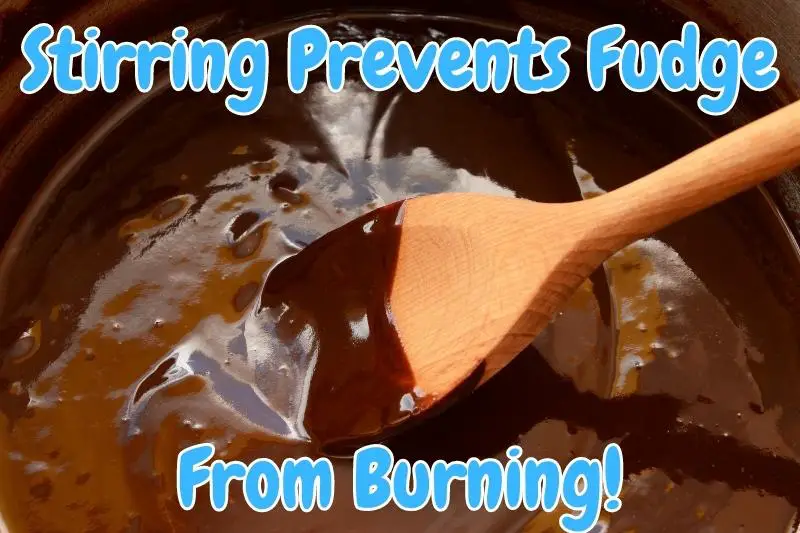
Once the fudge has hit the correct temperature, this is when you can stop stirring. All that muscle work will help ensure a smooth texture and prevent your fudge from burning!
Make Sure To Use The Right Tools!
Making fudge requires a variety of tools in the kitchen. It is important to use a tall saucepan to avoid spillage. It is also important to invest in a high-quality candy thermometer to ensure it has reached the right temperature. A wooden spoon or spatula also comes in handy when mixing fudge.
I find that using the right tools for the job help increase your success in the perfect dessert!
*By the way, if you’re looking for a new set of wooden spoons, I use the OXO Good Grips 3-Piece Wooden Spoon Set that has lasted me for a long time. You can check out this wooden spoon set on Amazon!
The boiling stage is one of the most important steps in the fudge-making process. You’ll want to make sure you’re boiling your mixture in a large saucepan.
Make sure it is quite tall, as you don’t want your mixture boiling up over the top and spilling all over the place!
Once the fudge mixture gets going it will boil quite vigorously, so always err on the side of caution and use a deeper saucepan to prevent messy spills.
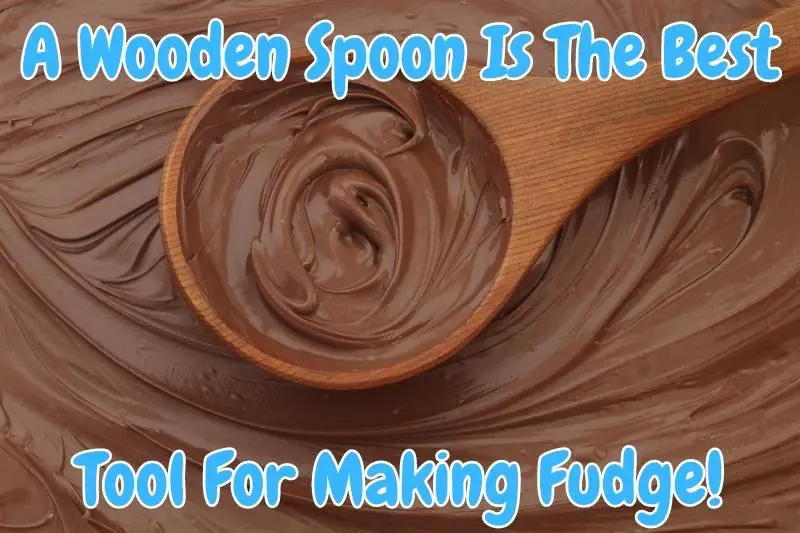
Another critically important piece of equipment you need in the kitchen is a candy thermometer.
You may have a meat thermometer on hand already, but you should never use a meat thermometer when making candy or fudge.
Meat thermometers are typically much shorter than candy thermometers, which can increase your risk of burns when you check your fudge as it’s boiling.
Candy thermometers are typically about twelve inches long, which provides you with a safer distance to check your fudge’s temperature.
Finally, make sure you invest in a high-quality wooden spoon.
Wooden spoons are perfect for mixing your fudge once it’s cooled to the right temperature and provide you with a safe and sturdy handle to grab onto.
Every home chef should have at least one or two wooden spoons handy while working in the kitchen.
Final Thoughts
Fudge is such a rich and decadent dessert that feels like absolute velvet in your mouth. The last thing you want is a bite of graininess to accompany that smooth texture.
By following these simple tips you’ll be well on your way to whipping up a smooth batch of fudge. Now that you know exactly how to fix grainy fudge, it’s time to get cooking!
